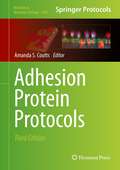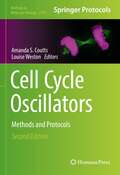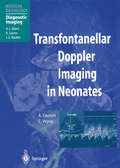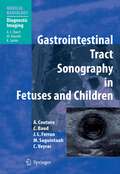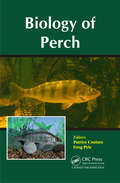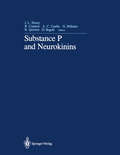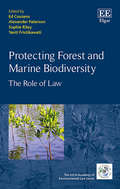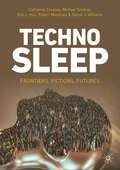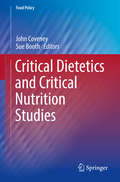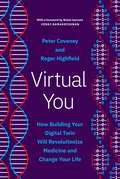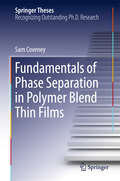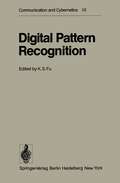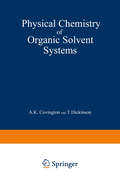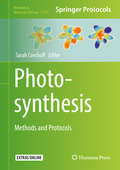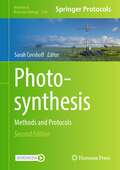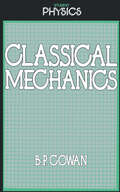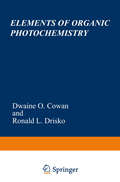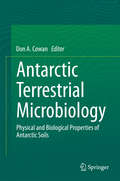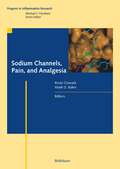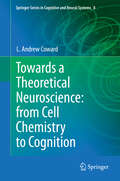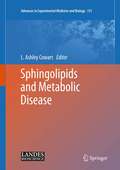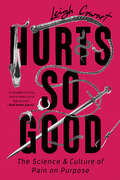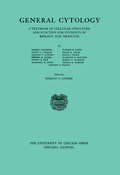- Table View
- List View
Adhesion Protein Protocols (Methods in Molecular Biology #1046)
by Amanda S. CouttsCellular adhesion is a fundamental process that influences numerous biological activities such as morphogenesis, cell motility and division, as well as signalling. In addition, adhesion is a process important not only in normal physiology and development, but also in disease states such as tumourigenesis, cardiovascular disease, inflammation and infection. There are a plethora of proteins involved in adhesion-related events with a huge diversity in function. As a result, a wide variety of techniques exist to study adhesion related proteins and processes. In Adhesion Protein Protocols, Third Edition, chapters cover techniques to gain insight into the complex and incompletely understood processes that are involved in cellular adhesion. Written in the successful Methods in Molecular Biology series format, chapters include introductions to their respective topics, lists of the necessary materials and reagents, step-by-step, readily reproducible protocols, and notes on troubleshooting and avoiding known pitfalls. Authoritative and easily accessible, Adhesion Protein Protocols, Third Edition will be useful for both those new to the field of adhesion protein research as well as the more experienced scientist.
Cell Cycle Oscillators: Methods and Protocols (Methods in Molecular Biology #2329)
by Amanda S. Coutts Louise WestonThis book brings together a unique collection of protocols that cover novel and specialized techniques as well as updated and improved adaptations of more standard procedures involving the cell cycle and its regulation by oscillatory networks, exploring recent progress in the field from both holistic and reductionist perspectives. The edition provides a space for researchers to highlight and explore the latest developments in molecular biology and biochemical techniques for studying oscillatory networks and to share these across the research community to facilitate further progress. Written in the highly successful Methods in Molecular Biology series format, chapters include introductions to their respective topics, lists of the necessary materials and reagents, step-by-step, readily reproducible laboratory protocols, and tips on troubleshooting and avoiding known pitfalls. Authoritative and up-to-date, Cell Cycle Oscillators: Methods and Protocols, Second Edition serves as an invaluable guide for those new to the field as well as the more experienced scientist.Chapter 19 is available open access under a CC BY 4.0 license.
Transfontanellar Doppler Imaging in Neonates (Medical Radiology)
by A. Couture C. VeyracThis book examines in detail the role of transfontanellar pulsed and color Doppler imaging in the fetus and neonate. After an introductory chapter its use in the normal neonate is considered. Results of the hemodynamic evaluation of 491 newborns aged from 32 weeks of gestation to 9 months by means of pulsed and color Doppler are reported. Normal values of the resistive index as determined by this technique are documented, and systolic, diastolic, and mean velocities in seven different vessels are presented. It is concluded that Doppler ultrasonography enables reliable analysis of arterial and venous velocities. Subsequent chapters examine the use of transfontanellar Doppler imaging in a variety of commonly encountered pathological conditions.
Gastrointestinal Tract Sonography in Fetuses and Children (Medical Radiology)
by Alain Couture C. Baud F.L. Ferran Magali Saguintaah Corinne VeyracThis is a state-of-the-art review of sonography of the gastrointestinal tract in fetuses, neonates and children. An introductory chapter compares sonography and magnetic resonance imaging of the fetal gastrointestinal tract. Coverage focuses on technique, pitfalls and findings in applications including antropyloric diseases, bowel obstruction, bowel wall thickening, colitis, appendicitis, intussusception, abdominal wall and umbilical abnormalities, intraperitoneal tumors and trauma, with high-quality illustrations. Includes a quiz based on 15 case reports.
Biology of Perch
by Patrice Couture Greg PyleThe genus Perca includes only three species of fish, but they are ubiquitous and abundant in freshwater and brackish environments of the northern hemisphere, from North America to Europe and Asia. These species are important both ecologically and economically. In Biology of Perch, world-renowned specialists review and update the biology of these fi
Substance P and Neurokinins: Proceedings of “Substance P and Neurokinins—Montréal '86” A Satellite Symposium of the XXX International Congress of The International Union of Physiological Sciences
by Rejean Couture A. Claudia Cuello Georges Pelletier Remi Quirion Domenico RegoliSarajevo was the site of the first international meeting on substance P. It was held in 1961, thirty years after the first report of the discovery of substance P by Von Euler and Gaddum. The proceedings which follow are from a symposium held twenty-five years after the first meeting. These twenty-five years have seen a vast expansion in this field ofresearch. This family of peptides now includes a number of different mammalian and non-mammalian related peptides. Beyond the early physiological and pharmacological studies, there is important new information coming from the full spectrum of disciplines in the basic medical sciences, including molecular biology, which has given us important insights into the biosynthetic mechanisms of origin of these peptides. Montreal was chosen as the site for the 1986 meeting. The name given to it was "Sub stance P & Neurokinins-Montreal '86." This name was modelled after the one held in Dublin in 1982, but neurokinins were added to acknowledge the broader family of peptides. The meeting was held as a Satellite Symposium of the XXX International Congress of the International Union of Physiological Sciences in Vancouver. The venue was McGill University, and the dates were 21-23 July, 1986.
Protecting Forest and Marine Biodiversity: The Role of Law (The IUCN Academy of Environmental Law series)
by Ed Couzens Alexander Paterson Sophie Riley Yanti FristikawatiThis timely book considers appropriate legal practices to use to promote conservation, protection and sustainable use of biological diversity in forest and marine areas. The breadth of issues explored across these two themes is immense, and the book identifies both key differences, and striking commonalities between them. Law-makers, managers and users often have little understanding of either the complexity or the true value of biological diversity and of what is needed to preserve forest and marine ecosystems, and to keep inter-relationships between species within them healthy. Regulators face significant and practical challenges, requiring the adoption of legal frameworks in the context of scientific uncertainty. This book provides critical and comparative reflections on the role of law in both of these biodiversity contexts. Key issues not previously addressed through the law are considered – for example, the lack of international governance of peat; and the moral problem of labelling certain species as ‘alien’ or ‘invasive’. Learned contributors draw valuable lessons for those seeking to protect biodiversity and understand its governance, from analysis of experiences gained forging international and national legal frameworks. With a blend of local and global perspectives, across a wide range of countries and policies, the book will appeal to academics and students in law, international, regional and domestic policymakers, lawmakers, NGOs and conservation agencies.
Technosleep: Frontiers, Fictions, Futures
by Catherine Coveney Michael Greaney Eric L. Hsu Robert Meadows Simon J. WilliamsThis book draws on a variety of substantive examples from science, technology, medicine, literature, and popular culture to highlight how a new technoscientifically mediated and modified phase and form of technosleep is now in the making – in the global north at least; and to discuss the consequences for our relationships to sleep, the values we accord sleep and the very nature and normativities of sleep itself.The authors discuss how technosleep, at its simplest denotes the ‘coming together’ or ‘entanglements’ of sleep and technology and sensitizes us to various shifts in sleep–technology relations through culture, time and place. In doing so, it pays close attention to the salience and significance of these trends and transformations to date in everyday/night life, their implications for sleep inequalities and the related issues of sleep and social justice they suggest.
Critical Dietetics and Critical Nutrition Studies (Food Policy)
by John Coveney Sue BoothThis second volume in the Food Policy series focuses on critical nutrition and dietetics studies, offering an innovative and interdisciplinary exploration of the complexities of the food supply and the actors in it through a new critical lens. The volume provides an overview of the growth of critical nutrition and dietetics since its inception in 2009, as well as commentary on its continuing relevance and its applicability in the fields of dietetic education, research, and practice. Chapters address key topics such as how to bring critical dietetics into conventional practice, applying critical diets in clinical practice, policy applications, and new perspectives on training and educating a critical nutrition and dietetic workforce. Contributing authors from around the globe also discuss the role of critical nutrition dietetics in industry, private practice, and consultancy, as well the role of critical dietetics in addressing the food, hunger, and health issues associated with the world economic crisis. The authors designed the volume to be a reference work for students enrolled in undergraduate and postgraduate courses in Critical Nutrition, Critical Food Studies, and Critical Dietetics. Each chapter offers concise aims and learning outcomes, as well as assignments for students and a concise chapter summary. These features enhance the value of the volume as a learning tool.
Virtual You: How Building Your Digital Twin Will Revolutionize Medicine and Change Your Life
by Peter Coveney Roger HighfieldThe visionary science behind the digital human twins that will enhance our health and our futureVirtual You is a panoramic account of efforts by scientists around the world to build digital twins of human beings, from cells and tissues to organs and whole bodies. These virtual copies will usher in a new era of personalized medicine, one in which your digital twin can help predict your risk of disease, participate in virtual drug trials, shed light on the diet and lifestyle changes that are best for you, and help identify therapies to enhance your well-being and extend your lifespan—but thorny challenges remain.In this deeply illuminating book, Peter Coveney and Roger Highfield reveal what it will take to build a virtual, functional copy of a person in five steps. Along the way, they take you on a fantastic voyage through the complexity of the human body, describing the latest scientific and technological advances—from multiscale modeling to extraordinary new forms of computing—that will make “virtual you” a reality, while also considering the ethical questions inherent to realizing truly predictive medicine.With an incisive foreword by Nobel Prize–winning biologist Venki Ramakrishnan, Virtual You is science at its most astounding, showing how our virtual twins and even whole populations of virtual humans promise to transform our health and our lives in the coming decades.
Virtual You: How Building Your Digital Twin Will Revolutionize Medicine and Change Your Life
by Peter Coveney Roger HighfieldThe visionary science behind the digital human twins that will enhance our health and our futureVirtual You is a panoramic account of efforts by scientists around the world to build digital twins of human beings, from cells and tissues to organs and whole bodies. These virtual copies will usher in a new era of personalized medicine, one in which your digital twin can help predict your risk of disease, participate in virtual drug trials, shed light on the diet and lifestyle changes that are best for you, and help identify therapies to enhance your well-being and extend your lifespan—but thorny challenges remain.In this deeply illuminating book, Peter Coveney and Roger Highfield reveal what it will take to build a virtual, functional copy of a person in five steps. Along the way, they take you on a fantastic voyage through the complexity of the human body, describing the latest scientific and technological advances—from multiscale modeling to extraordinary new forms of computing—that will make “virtual you” a reality, while also considering the ethical questions inherent to realizing truly predictive medicine.With an incisive foreword by Nobel Prize–winning biologist Venki Ramakrishnan, Virtual You is science at its most astounding, showing how our virtual twins and even whole populations of virtual humans promise to transform our health and our lives in the coming decades.
Fundamentals of Phase Separation in Polymer Blend Thin Films (Springer Theses)
by Sam CoveneyThis work sheds new light on fundamental aspects of phase separation in polymer-blend thin films. A key feature underlying the theoretical models is the unification of one-dimensional thermodynamic phase equilibria with film evolution phenomena in two- and three dimensions. Initially, an established 'phase portrait' method, useful for visualising and calculating phase equilibria of polymer-blend films, is generalised to systems without convenient simplifying symmetries. Thermodynamic equilibria alone are then used to explain a film roughening mechanism in which laterally coexisting phases can have different depths in order to minimise free energy. The phase portraits are then utilised to demonstrate that simulations of lateral phase separation via a transient wetting layer, which conform very well with experiments, can be satisfactorily explained by 1D phase equilibria and a 'surface bifurcation' mechanism. Lastly, a novel 3D model of coupled phase separation and dewetting is developed, which demonstrates that surface roughening shadows phase separation in thin films.
Digital Pattern Recognition (Communication and Cybernetics #10)
by T. M. Cover Edwin Diday K. S. Fu A. Rosenfeld J. C. Simon T. J. Wagner J. S. Weszka J. J. WolfDuring the past fifteen years there has been a considerable growth of interest in problems of pattern recognition. Contributions to the blossom of this area have come from many disciplines, including statistics, psychology, linguistics, computer science, biology, taxonomy, switching theory, communication theory, control theory, and operations research. Many different approaches have been proposed and a number of books have been published. Most books published so far deal with the decision-theoretic (or statistical) approach or the syntactic (or linguistic) approach. Since the area of pattern recognition is still far from its maturity, many new research results, both in theory and in applications, are continuously produced. The purpose of this monograph is to provide a concise summary of the major recent developments in pattern recognition. The five main chapters (Chapter 2-6) in this book can be divided into two parts. The first three chapters concern primarily with basic techniques in pattern recognition. They include statistical techniques, clustering analysis and syntactic techniques. The last two chapters deal with applications; namely, picture recognition, and speech recognition and understanding. Each chapter is written by one or two distinguished experts on that subject. The editor has not attempted to impose upon the contributors to this volume a uniform notation and terminol ogy, since such notation and terminology does not as yet exist in pattern recognition.
Enhanced Optical and Electric Manipulation of a Quantum Gas of KRb Molecules (Springer Theses)
by Jacob P. CoveyThis thesis describes significant advances in experimental capabilities using ultracold polar molecules. While ultracold polar molecules are an idyllic platform for quantum chemistry and quantum many-body physics, molecular samples prior to this work failed to be quantum degenerate, were plagued by chemical reactions, and lacked any evidence of many-body physics. These limitations were overcome by loading molecules into an optical lattice to control and eliminate collisions and hence chemical reactions. This led to observations of many-body spin dynamics using rotational states as a pseudo-spin, and the realization of quantum magnetism with long-range interactions and strong many-body correlations.Further, a 'quantum synthesis' technique based on atomic insulators allowed the author to increase the filling fraction of the molecules in the lattice to 30%, a substantial advance which corresponds to an entropy-per-molecule entering the quantum degenerate regime and surpasses the so-called percolations threshold where long-range spin propagation is expected.Lastly, this work describes the design, construction, testing, and implementation of a novel apparatus for controlling polar molecules. It provides access to: high-resolution molecular detection and addressing; large, versatile static electric fields; and microwave-frequency electric fields for driving rotational transitions with arbitrary polarization. Further, the yield of molecules in this apparatus has been demonstrated to exceed 10^5, which is a substantial improvement beyond the prior apparatus, and an excellent starting condition for direct evaporative cooling to quantum degeneracy.
Physical Chemistry of Organic Solvent Systems
by A. CovingtonWe believe this to be the first monograph devoted to the physicochemical properties of solutions in organic solvent systems. Although there have 1 been a number of books on the subject of non-aqueous solvents - 4, they have been devoted, almost entirely, to inorganic solvents such as liquid ammonia, liquid sulphur dioxide, etc. A variety of new solvents such as dimethylformamide, dimethylsulphoxide and propylene carbonate have become commercially available over the last twenty years. Solutions in these solvents are of technological interest in connection with novel battery systems and chemical synthesis, while studies of ion solvation and transport properties have fostered academic interest. This monograph is primarily concerned with electrolytic solutions although discussion of non-electrolyte solutions has not been excluded. We have deliberately omitted consideration of the important area of solvent extraction, since this has been adequately covered elsewhere. Our contributors were asked to review and discuss their respective areas with particular reference to differences in technique necessitated by use of non-aqueous solvents while not reiterating facts well-known from experience with aqueous solutions. We have striven to build their contributions into a coherent and consistent whole. We thank our con tributors for following our suggestions so ably and for their forebearance in the face of our editorial impositions.
Photosynthesis: Methods and Protocols (Methods in Molecular Biology #1770)
by Sarah CovshoffThis user-friendly book provides a range of classical and modern techniques for the study of photosynthesis in a manner accessible to a broad spectrum of researchers. Broken into four sections, it explores the measurement of physiological photosynthetic parameters, quantifying photosynthetic enzyme abundance and catalytic activity, visualizing cellular and sub-cellular phenotypes, and photosynthesis-inspired energy generation. Written for the highly successful Methods in Molecular Biology series, chapters include introductions to their respective topics, lists of the necessary materials and reagents, step-by-step laboratory protocols, and tips on troubleshooting and avoiding known pitfalls. Authoritative and practical, Photosynthesis: Methods and Protocols aims to aid scientists working toward exciting developments in the understanding and application of photosynthesis.
Photosynthesis: Methods and Protocols (Methods in Molecular Biology #2790)
by Sarah CovshoffThis fully updated edition explores fundamental protocols for the study of photosynthesis in a manner accessible to a broad spectrum of researchers. Featuring protocols to examine light response curves and gas exchange measurements for a variety of samples, the book includes new protocols on photosynthesis in the adaxial and abaxial sides of a leaf, non-foliar organs, and aquatic systems. Protocols and best practice for eddy covariance, thermal, spectral, and hyperspectral imaging and data analysis, as well as stable isotope labeling and quantification of photosynthetic metabolites, are introduced alongside fresh insights on many more topics. Written for the highly successful Methods in Molecular Biology series, chapters include introductions to their respective topics, lists of the necessary materials and reagents, step-by-step and readily reproducible laboratory protocols, and tips on troubleshooting and avoiding known pitfalls. Authoritative and up-to-date, Photosynthesis: Methods and Protocols, Second Edition provides an ideal guide to the improved technologies expanding our capabilities to study photosynthesis today.
Classical Mechanics (Student Physics Series)
by Brian CowanThe study of mechanics plays a central role in physics for a whole variety of reasons. It was one of the earliest of the quantitative sciences, and had immediate practical applications. These ranged from the study of the motion of projectiles in warfare to the motion of the planets, predicting the seasons, eclipses, etc. At the present time, even though superseded on the very small scale by quantum theory and on the very large scale by the theory of relativity, the mechanics of Newton is perfectly adequate for treating a wide spectrum of problems from the • '"etic theory of gases to the motion of space vehicles. Furthermore, the science of mechanics is regarded by many as the epitome of a good scientific theory and for this reason is studied by philosophers and social scientists alike as an exemplar of the 'scientific method'. We shall commence in Chapter 1 with a brief historical outline of the development of mechanics, mentioning the names and dates of the main participants and summarizing their contributions. Preface vii Chapter 1 Newton's laws 1. 1 Historical introduction Primitive ideas about mechanics were exemplified by the state ments of Aristotle (384-322 Be), who asserted that a force was necessary to maintain motion. Furthermore, he believed that there were different laws for heavenly and earthly bodies.
Elements of Organic Photochemistry
by D. CowanIn the past fifteen years organic photochemistry has undergone a greater change and has stimulated more interest than probably any other area of organic chemistry. What has resulted is a population explosion, that is, an ever-increasing number of organic chemists are publishing important and exciting research papers in this area. Professor Bryce-Smith in the introduc tion to a recent volume of the Specialist Periodical Report (Photochemistry, Volume 6), which reviews the photochemical literature in yearly intervals, states that "the flood of photochemical literature is showing some signs of abatement from the high levels of two or three years ago .... " However, Volume 6 of that periodical contains 764 pages of excellent but very concise reviews. We expect the development of the mechanistic aspects of organic photo chemistry to continue at the present pace as new methods are developed to probe in increasing detail and shorter time scales the photochemical dynamics of both old and new photoreactions. Since photochemistry is no longer the sole domain of the specialist, it is relatively safe to predict a dramatic increase in the near future of the synthetic and industrial uses of organic photo chemistry .
Antarctic Terrestrial Microbiology: Physical and Biological Properties of Antarctic Soils
by Don A. CowanThis book brings together many of the world’s leading experts in the fields of Antarctic terrestrial soil ecology, providing a comprehensive and completely up-to-date analysis of the status of Antarctic soil microbiology.Antarctic terrestrial soils represent one of the most extreme environments on Earth. Once thought to be largely sterile, it is now known that these diverse and often specialized extreme habitats harbor a very wide range of different microorganisms.Antarctic soil communities are relatively simple, but not unsophisticated. Recent phylogenetic and microscopic studies have demonstrated that these communities have well established trophic structuring and play a significant role in nutrient cycling in these cold and often dry desert ecosystems. They are surprisingly responsive to change and potentially sensitive to climatic perturbation.Antarctic terrestrial soils also harbor specialized ‘refuge’habitats, where microbial communities develop under (and within) translucent rocks. These cryptic habitats offer unique models for understanding the physical and biological ‘drivers’ of community development, function and evolution.
Sodium Channels, Pain, and Analgesia (Progress in Inflammation Research)
by Kevin Coward Mark D. BakerSodium channels confer excitability on neurons in nociceptive pathways and exhibit neuronal tissue specific and injury regulated expression. This volume provides recent insights into the control of expression, functioning and membrane trafficking of nervous system sodium channels and reviews why sodium channel sub-types are potentially important drug targets in the treatment of pain. The roles of sodium channels in dental and visceral pain are also addressed. The emerging role of sodium channel Nav1.3 in neuropathic states is another important theme. Authors from the pharmaceutical industry discuss pharmacological approaches to the drug targeting of sodium channels, and in particular Nav1.8, exclusively expressed in nociceptive neurons. The final chapter highlights the functional diversity of sodium channels in part provided by post-transcriptional processing and the insights into sodium channel function that are being provided by tissue specific and inducible gene knock-out technology.
Towards a Theoretical Neuroscience: from Cell Chemistry to Cognition (Springer Series in Cognitive and Neural Systems #8)
by L Andrew CowardThe book explains how to understand cognition in terms of brain anatomy, physiology and chemistry, using an approach adapted from techniques for understanding complex electronic systems. These techniques create hierarchies of information process based descriptions on different levels of detail, where higher levels contain less information and can therefore describe complete cognitive phenomena, but are more approximate. The nature of the approximations are well understood, and more approximate higher level descriptions can therefore be mapped to more precise detailed descriptions of any part of a phenomenon as required. Cognitive phenomena, the anatomy and connectivity of major brain structures, neuron physiology, and cellular chemistry are reviewed. Various cognitive tasks are described in terms of information processes performed by different major anatomical structures. These higher level descriptions are selectively mapped to more detailed physiological and chemical levels.
Sphingolipids and Metabolic Disease (Advances in Experimental Medicine and Biology #721)
by L. Ashley CowartCurrent thinking holds that obesity derives primarily from overnutrition (though compelling arguments for other mechanisms, like endocrine disruption by environmental pollutants, also gain support from the literature). In animals, overnutrition is initially handled by adipose tissue expansion; however, exhaustion of this route of lipid sequestering results in oversupply of lipid to other tissues including skeletal muscle, heart, liver, and others. Failure of these tissues to clear excess lipids through either metabolism or sequestration into putatively inert triacylglycerols results in perturbation of bioactive lipid metabolism in cells. In particular, aberrant generation of bioactive sphingolipids is implicated in a multitude of pathological outcomes of metabolic disease including insulin resistance, inflammation, cardiomyopathy, and others. This volume addresses not only the fundamentals of sphingolipid metabolism and analysis, but also the roles of sphingolipids in these disease processes.
Hurts So Good: The Science and Culture of Pain on Purpose
by Leigh CowartAn exploration of why people all over the world love to engage in pain on purpose--from dominatrices, religious ascetics, and ultramarathoners to ballerinas, icy ocean bathers, and sideshow performersMasochism is sexy, human, reviled, worshipped, and can be delightfully bizarre. Deliberate and consensual pain has been with us for millennia, encompassing everyone from Black Plague flagellants to ballerinas dancing on broken bones to competitive eaters choking down hot peppers while they cry. Masochism is a part of us. It lives inside workaholics, tattoo enthusiasts, and all manner of garden variety pain-seekers. At its core, masochism is about feeling bad, then better—a phenomenon that is long overdue for a heartfelt and hilarious investigation. And Leigh Cowart would know: they are not just a researcher and science writer—they&’re an inveterate, high-sensation seeking masochist. And they have a few questions: Why do people engage in masochism? What are the benefits and the costs? And what does masochism have to say about the human experience? By participating in many of these activities themselves, and through conversations with psychologists, fellow scientists, and people who seek pain for pleasure, Cowart unveils how our minds and bodies find meaning and relief in pain—a quirk in our programming that drives discipline and innovation even as it threatens to swallow us whole.
General Cytology: A Textbook of Cellular Structure and Function for Students of Biology and Medicine
by Edmund V. CowdryThis volume was, at the time of publication, the largest and most comprehensive book on the subject of cytology, a branch of zoology which had grown considerably in the years before 1924. It was written by the foremost cytologists in the United States, including Robert Chambers, Edwin G. Conklin, Edmund V. Cowdry, Merle H. Jacobs, Ernest E. Just, Margaret R. Lewis, Warren H. Lewis, Frank R. Lillie, Ralph S. Lillie, Clarence E. McClung, Albert P. Mathews, Thomas H. Morgan, and Edmund B. Wilson.
